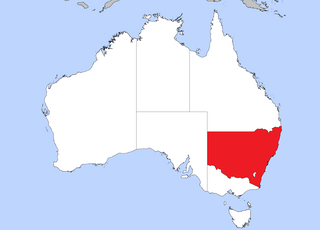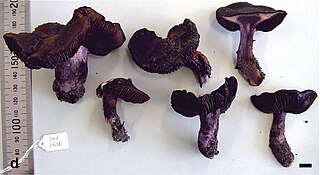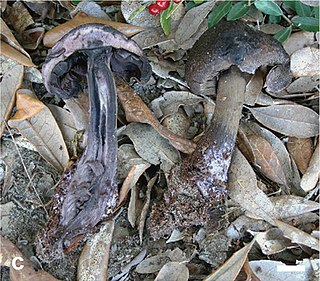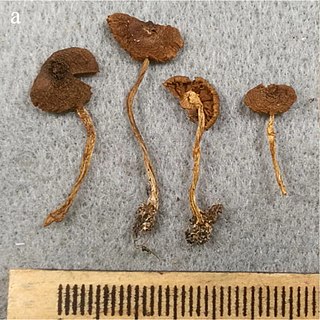
Cortinarius is a globally distributed genus of mushrooms in the family Cortinariaceae. It is suspected to be the largest genus of agarics, containing over 2,000 widespread species. A common feature among all species in the genus Cortinarius is that young specimens have a cortina (veil) between the cap and the stem, hence the name, meaning curtained. Most of the fibres of the cortina are ephemeral and will leave no trace once gone, except for limited remnants on the stem or cap edge in some species. All have a rusty brown spore print. The common names cortinar and webcap refer to members of the genus. Due to dangerous toxicity of several species and the fact that it is difficult to distinguish between various species of the genus, non-expert consumption of mushrooms from the genus is discouraged.

The Cortinariaceae are a large family of gilled mushrooms found worldwide, containing over 2100 species. The family takes its name from its largest genus, the varied species of the genus Cortinarius. Many genera formerly in the Cortinariaceae have been placed in various other families, including Hymenogastraceae, Inocybaceae and Bolbitiaceae.

Cortinarius violaceus, commonly known as the violet webcap or violet cort, is a fungus in the webcap genus Cortinarius native across the Northern Hemisphere. The fruit bodies are dark purple mushrooms with caps up to 15 cm (6 in) across, sporting gills underneath. The stalk measures 6 to 12 centimetres by 1 to 2 centimetres, sometimes with a thicker base. The dark flesh has a smell reminiscent of cedar wood. Forming symbiotic (ectomycorrhizal) relationships with the roots of various plant species, C. violaceus is found predominantly in conifer forests in North America and deciduous forests in Europe.

Cortinarius archeri is a species of mushroom in the genus Cortinarius native to Australia. The distinctive mushrooms have bright purple caps that glisten with slime, and appear in autumn in eucalypt forests.

Cortinarius maculobulga is a species of truffle-like fungus in the family Cortinariaceae. Found only in New South Wales, Australia, it was described as new to science in 2010.

Cortinarius nebulobrunneus is a species of truffle-like fungus in the family Cortinariaceae. Found in New South Wales, Australia, the species was described as new to science in 2010.

Cortinarius australiensis, commonly known as the skirt webcap, is a species of mushroom in the genus Cortinarius native to Australia and New Zealand. The white mushrooms appear in autumn and can grow very large, with their caps reaching 30 cm (12 in) in diameter.
Egon Horak is an Austrian mycologist who has described more than 1000 species of fungi, including many from the Southern Hemisphere, particularly New Zealand and South America. He was an executive editor of the scientific journal Sydowia from 1975 to 1989, and a member of the editorial board afterwards.

Cortinarius kioloensis is a fungus native to Australia. It was described in 2009 by Alec Wood, and is related to the Northern Hemisphere species Cortinarius violaceus.

Cortinarius hallowellensis is a fungus native to Western Australia and Tasmania. It was described in 2009 by Alec Wood, and is related to the northern hemisphere species Cortinarius violaceus. The main species in the North America group, Cortinarius monticola, has also been identified, but has not been found in Australia. Despite this relative isolation, there is genetic interchange between the North American species and the Australian species.

Cortinarius palatinus is a fungus native to Costa Rica. It was described in 2015 by Emma Harrower and colleagues, and is closely related to the northern hemisphere species Cortinarius violaceus.

Cortinarius neotropicus is a fungus native to Costa Rica. It was described in 2015 by Emma Harrower and colleagues, and is closely related to the northern hemisphere species Cortinarius violaceus.

Cortinarius altissimus is a fungus native to Guyana. It was described in 2015 by Emma Harrower and colleagues, and is closely related to the northern hemisphere species Cortinarius violaceus.
Cortinarius jenolanensis is a fungus native to Australia. It was described in 2009 by Alec Wood, from a specimen collected at the Jenolan Caves on 30 April 1988. It has also been recorded from Tidbinbilla Nature Reserve in the Australian Capital Territory.
Cortinarius atrolazulinus is a fungus native to New Zealand.

Cortinarius atrotomentosus is a fungus native to Florida in the southeastern United States, where it grows in association with southern live oak. It was described in 2015 by Emma Harrower and colleagues, and is closely related to the northern hemisphere species Cortinarius violaceus.
Cortinarius subcalyptrosporus is a fungus native to Borneo, where it was originally collected by E.J.H. Corner on the slopes of Mount Kinabalu in 1964 and described by Meinhard Michael Moser in 1986. Specimens from New Zealand classified as this species are Cortinarius kioloensis. It is poorly known.
Cortinarius atroviolaceus is a fungus native to Borneo, where it was originally collected by E.J.H. Corner on the slopes of Mount Kinabalu in 1964 and described by Meinhard Michael Moser in 1986. Specimens from New Zealand classified as this species are probably a different species. It is poorly known.

Cortinarius subsaniosus is a species of webcap mushroom known from north and central Europe, where it grows on sandy soil in association with willows. It produces small yellowish brown mushrooms. The species was described in 2020 by Kare Liimatainen and Tuula Niskanen. Its name refers to its affinity to C. saniosus, to which it is closely related. Along with five other British webcaps, C. subsaniosus was selected by Kew Gardens as a highlight of taxa described by the organisation's staff and affiliates in 2020.











